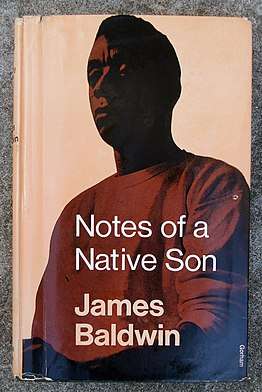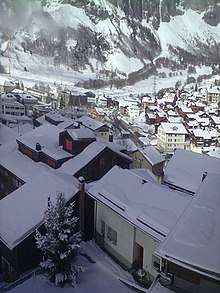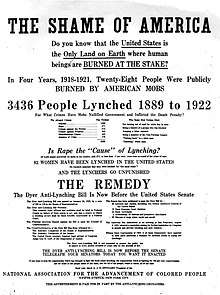Stranger in the Village
"Stranger in the Village" is an essay by African-American novelist James Baldwin about his experiences in Leukerbad, Switzerland, after he nearly suffered a breakdown. The essay was originally published in Harper's Magazine, October 1953,[1] and later in his 1955 collection, Notes of a Native Son.
 Cover of Notes of a Native Son (British edition), in which "Strangers in the Village" appears as part of a collection | |
| Author | James Baldwin |
|---|---|
| Published | 1953 |
| Publisher | Harper's Magazine |
In the summer of 1951, Baldwin almost suffered a breakdown, for which his partner, Lucien Happersberger, took him to an established Swiss health-resort in the Valais Alps, known as Leukerbad.[2] Baldwin declares that, while he is a stranger in the village of Leukerbad, he also feels like a stranger in the village of the United States of America as an African American.[3]
Plot summary
The essay is an account of Baldwin's experiences in Leukerbad, Switzerland. Residents of Leukerbad were fascinated by Baldwin's blackness; according to Baldwin they had never seen a black man before. The village is almost four hours from Milan Italy. Because it is located in Swiss alps, it is extremely isolated. Baldwin being an African American is the only Black person the villagers have ever seen thus making him a stranger in the village.[4] Baldwin was a stranger in Leukerbad, the Swiss village, but there was no possibility for blacks to be strangers in the United States, nor for whites to achieve the fantasy of an all-white America purged of blacks. This fantasy about the disposability of black life is a constant in American history.[5]
Baldwin further goes on to explain the relationship between American and European history, by explicitly pointing out that American history encompasses the history of the Negro, while European history lacks the African-American dimension. Baldwin observes that in America the Negro is “an inescapable part of the general social fabric” and that “Americans attempt until today to make an abstraction of the Negro.”[6][7]:125

Baldwin argues that white Americans try to retain a separation between their history and black history despite the interdependence between the two. It is impossible for Americans to become European again “recovering the European innocence”[3] through the neglect of the American Negro; the American Negro is a part of America permanently pressed and carved into an undeniable history.[8]
Baldwin relates his experiences in a small Swiss village composed of people who had never seen a black man before he arrived in the village in the summer of 1951. Baldwin describes a kind of naive racism: children who shout "Neger!" when they see him, unaware of the echoes he hears from his past when others shouted a more damning word ("Nigger!") in the streets of New York City; local Catholic residents (the main religion of the village) who donate money to "buy" Africans so that missionaries can convert those Africans to Catholicism, told to Baldwin with pride, again without realizing the ominous undertones of that practice for a man who is a descendant of African slaves. Yet, there is also a more sinister racism, even in a remote village that has direct experience with only one Black man: men who describe Baldwin as "le sale negre" ('the dirty Black man') behind his back and assume that he stole wood from them, or of children who "scream in genuine anguish" when he approaches them because they have been taught that "the devil is a black man."[8][3]
The final sentence in his essay articulates a defiant claim by Baldwin and an understanding that the villagers' and white Americans' need to reach, losing thereby what Baldwin describes as "the jewel" of the white man's naivete - in other words, white Americans' willful desire to ignore white privilege and the effects of centuries of racism and systemic discrimination against Black Americans: "This world is white no longer, and it will never be white again." Therefore, as Baldwin put it, “people are trapped in history and history is trapped in them.”[6][7]:119
Form and themes
Baldwin appears to be telling the story of his experiences in that tiny Swiss village. He uses the story as a metaphor for the history of race relations in the United States, describing the power discrepancy between whites of European background and African Americans who were forcibly brought to the US as slaves.[9]

Baldwin speaks of racism in the United States and in Leukerbad, Switzerland, drawing parallels between the two. This essay is autobiographical in nature, as Baldwin speaks of his own experiences. "Stranger in The Village", in many forms, is a protest against America for its treatment of African Americans, putting its racism on full display. In the essay, Baldwin raises questions of his own identity and how he fits into society in both the United States and in Leukerbad, where the family of his lover, Lucien Happersberger, had a chalet in a village up in the mountains.[9]
Reception and influence
The legacy of "Stranger In the Village" is tied to the legacy and reception of the book in which it is featured, "Notes of a Native Son". The book is widely regarded as a classic of the black autobiographical genre. The Modern Library placed it at number 19 on its list of the 100 best 20th-century nonfiction books. Since Baldwin's passing on December 1, 1987, his writings have been published worldwide and are still known as essential emblems of the American canon.[10]
References
- Baldwin, James. October 1953. "Stranger in the Village (subscription required)." Harper's Magazine.
- Cole, Teju (2014-08-19). "Black Body: Rereading James Baldwin's "Stranger in the Village"". ISSN 0028-792X. Retrieved 2019-12-10.
- Baldwin, James. "Stranger in the Village (annotated)," edited by J. R. Garza. Genius.
- Lamons, Brent (2006-08-15). "The Internal Odyssey of Identity: James Baldwin, Go Tell It on the Mountain, and History". Electronic Theses and Dissertations.
- Cole, Teju (2014-08-19). "Black Body: Rereading James Baldwin's "Stranger in the Village"". ISSN 0028-792X. Retrieved 2019-11-01.
- Griffin, Farah Jasmine, and Cheryl J. Fish. 1998. A Stranger in the Village: Two Centuries of African-American Travel Writing (subscription required). Boston: Beacon Press. OCLC 38304331.
- Baldwin, James. 1953. "Strangers in the Village."
- Baldwin, James. "Strangers in the Village." In Notes of a Native Son (revised ed.), edited by E. P. Jones. Boston, MA. ISBN 9780807006115. OCLC 794603960.
- Cole, Teju (2014-08-19). "Black Body: Rereading James Baldwin's "Stranger in the Village"". ISSN 0028-792X. Retrieved 2019-12-10.
- Joe (2016-08-02). "Recognizing James Baldwin's Legacy". Arthur Ashe Legacy. Retrieved 2019-11-05.